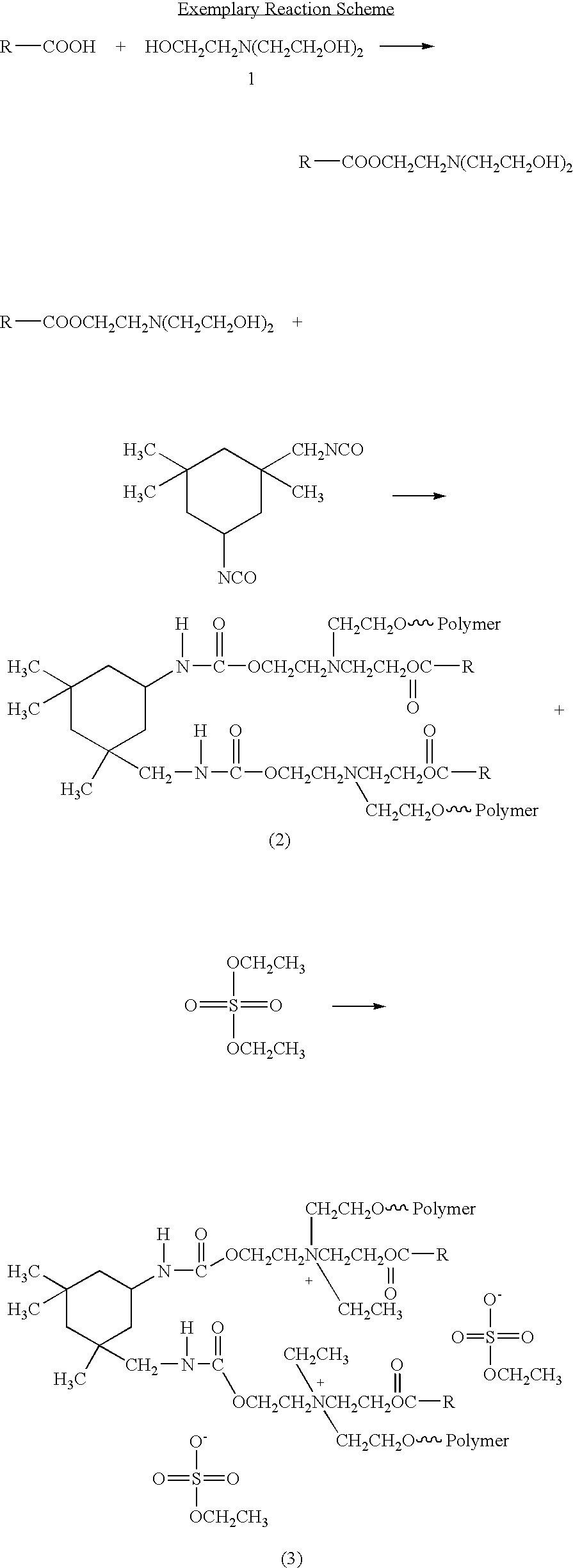Polyurethane emulsifiers
- Summary
- Abstract
- Description
- Claims
- Application Information
AI Technical Summary
Benefits of technology
Problems solved by technology
Method used
Image
Examples
example 1
Materials and Methods
[0065] In performing the following syntheses and preparing the following final formulations, the reagents which are used are indicated in the specific examples. Solvents, where used, are preferably distilled prior to use. Sources of other materials are indicated in the appropriate experimental section. In most instances, although not in every instance, trademarked materials are available from Alzo International, Inc., Sayreville, N.J.
[0066] Table 1 lists formulations 1-4 that include a cationic polyurethane emulsifier.
[0067] The polyurethane emulsifier here comprises the reaction product of 1 mole of behenic acid with 1 mole of triethanolamine that is polymerized by reaction with 1 mole of isophorone diisocyanate and subsequently quaternized by reaction with diethylsulfate.
TABLE 1Formulation1234Ingredients%%%%Mineral Oil (70 ssu)10.010.010.010.0Cationic Polyurethane Emulsifier4.06.08.010.0Deionized Water85.083.81.079.0Phenobact (antibacterial)1.01.01.01.010...
example 2
[0068] Table 2 lists formulations 5-8 and Table 3 lists formulations 9-12 that include a cationic polyurethane emulsifier as described in Example 1 of the invention.
TABLE 2Formulations5678Ingredients%%%%Isopropyl Palmitate10.010.010.010.0Cationic Polyurethane Emulsifier4.06.08.010.0Deionized Water82.080.078.076.0Glycerin3.03.03.03.0Phenobact1.01.01.01.0100.0100.0100.0100.0
[0069] Formulations 5 and 6 were fairly stable, but showed flocculation after standing for about 4 hours. Formulation 7 showed some flocculation after 2 to 3 weeks, while Formulation 8 was stable, showing no separation after one month's storage at room temperature. The viscosity of these emulsions is surprisingly low (less than 5 cps). Obtaining stability with a low viscosity emulsion is generally very difficult and it is usually achieved using highly charged, water soluble, monomeric, ionic surfactants. The illustrated formulations are believed to be the first stable, low viscosity emulsions made with a polymeri...
example 3
[0070] Table 4 lists formulations 13-16 and Table 5 lists formulations 17-18 that include a cationic polyurethane emulsifier as described in Example 1 of the invention.
TABLE 4Formulation13141516Ingredients%%%%Isopropyl Palmitate10.010.010.010.0Cationic Polyurethane Emulsifier8.08.08.08.0Deionized Water77.677.576.576.5Glycerin3.03.03.03.0Carbopol 9400.3———Natrosol 250 HR—0.5——PEG 6000 Distearate——1.5—Dermothix 100———1.5Triethanolamine0.1———Phenobact1.01.01.01.0100.0100.0100.0100.0
Formulations 13 through 16 use typical polymeric viscosity builders. Carbopol is anionic and complexes with the cationic polyurethane emulsifier to form noticable particles, but the viscosity is not increased. In Formulation 14, Natrosol is nonionic and the viscosity was 600 cps. PEG 6000 Distearate in Formulation 15 is a nonionic viscosity builder (stearic acid diester of 150 mole ethoxylated glycol) and the formulation had a viscosity of 3,300 cps. Dermothix 100 is a urethane dimer of 100 mole ethoxylat...
PUM
| Property | Measurement | Unit |
|---|---|---|
| Fraction | aaaaa | aaaaa |
| Fraction | aaaaa | aaaaa |
| Fraction | aaaaa | aaaaa |
Abstract
Description
Claims
Application Information
 Login to View More
Login to View More - R&D
- Intellectual Property
- Life Sciences
- Materials
- Tech Scout
- Unparalleled Data Quality
- Higher Quality Content
- 60% Fewer Hallucinations
Browse by: Latest US Patents, China's latest patents, Technical Efficacy Thesaurus, Application Domain, Technology Topic, Popular Technical Reports.
© 2025 PatSnap. All rights reserved.Legal|Privacy policy|Modern Slavery Act Transparency Statement|Sitemap|About US| Contact US: help@patsnap.com


